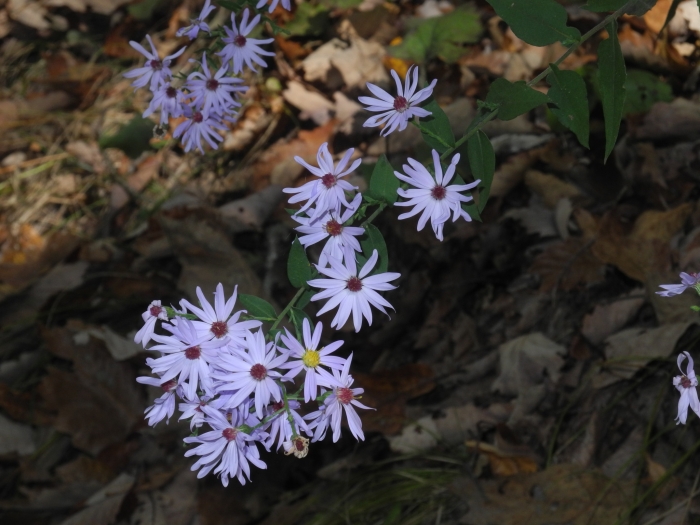Wavyleaf Aster
(Symphyotrichum undulatum)
Wavyleaf Aster (Symphyotrichum undulatum)
/
/

Michael J. Papay
CC BY 4.0
Image By:
Michael J. Papay
Recorded By:
Copyright:
CC BY 4.0
Copyright Notice:
Photo by: Michael J. Papay | License Type: CC BY 4.0 | License URL: http://creativecommons.org/licenses/by/4.0/ | Rights Holder: Michael J. Papay | Publisher: iNaturalist | Date Created: 2021-10-23T11:49:08-07:00 |

























Estimated Native Range
Summary
Symphyotrichum undulatum, commonly known as Wavyleaf Aster, is a perennial herb that is native to open woodlands, meadows, and prairies of eastern North America. It can grow to heights of 12-63 inches (30-160 cm) and is known for its distinctive wavy-edged leaves. The plant blooms from late summer into fall, typically from August through October, producing clusters of flowers with blue to purple, or sometimes lilac, ray florets surrounding cream or light yellow, which become purple, disk florets. The fruit of the Wavyleaf Aster is a cypsela, a small, dry, one-seeded fruit that is often mistaken for a seed, encased in a calyx sheath that aids in dispersal.
Wavyleaf Aster is valued for its late-season blooms that add color to gardens and naturalized areas when many other plants have finished flowering. It is often used in wildflower gardens, borders, and as part of pollinator-friendly plantings due to its attractiveness to bees and butterflies. This aster prefers full sun to partial shade and thrives in well-drained soils but is adaptable to various soil types. While generally low-maintenance, it can be susceptible to powdery mildew and rust, especially in humid conditions or when airflow is restricted. To maintain vigor and prevent overcrowding, division every few years is recommended. It is not known to be invasive and does not have aggressive roots, making it a good choice for gardeners seeking a reliable and environmentally beneficial plant.CC BY-SA 4.0
Wavyleaf Aster is valued for its late-season blooms that add color to gardens and naturalized areas when many other plants have finished flowering. It is often used in wildflower gardens, borders, and as part of pollinator-friendly plantings due to its attractiveness to bees and butterflies. This aster prefers full sun to partial shade and thrives in well-drained soils but is adaptable to various soil types. While generally low-maintenance, it can be susceptible to powdery mildew and rust, especially in humid conditions or when airflow is restricted. To maintain vigor and prevent overcrowding, division every few years is recommended. It is not known to be invasive and does not have aggressive roots, making it a good choice for gardeners seeking a reliable and environmentally beneficial plant.CC BY-SA 4.0
Plant Description
- Plant Type: Herb
- Height: 1-4 feet
- Width: 1-2 feet
- Growth Rate: Moderate
- Flower Color: Blue, Pink, Purple, White
- Flowering Season: Summer, Fall
- Leaf Retention: Deciduous
Growth Requirements
- Sun: Full Sun, Part Shade
- Water: Medium
- Drainage: Medium
Common Uses
Bee Garden, Bird Garden, Border Plant, Butterfly Garden, Low Maintenance
Natural Habitat
Native to open woodlands, meadows, and prairies of eastern North America
Other Names
Common Names: Wavy-Leaved Aster, Clasping Aster, Wavy-Leaf Aster, Waxyleaf Aster
Scientific Names: , Symphyotrichum undulatum, Aster asperifolius, Aster asperulus, Aster autumnalis, Aster autumnalis, Aster baldwinii, Aster claviger, Aster corrigiatus, Aster diversifolius
GBIF Accepted Name: